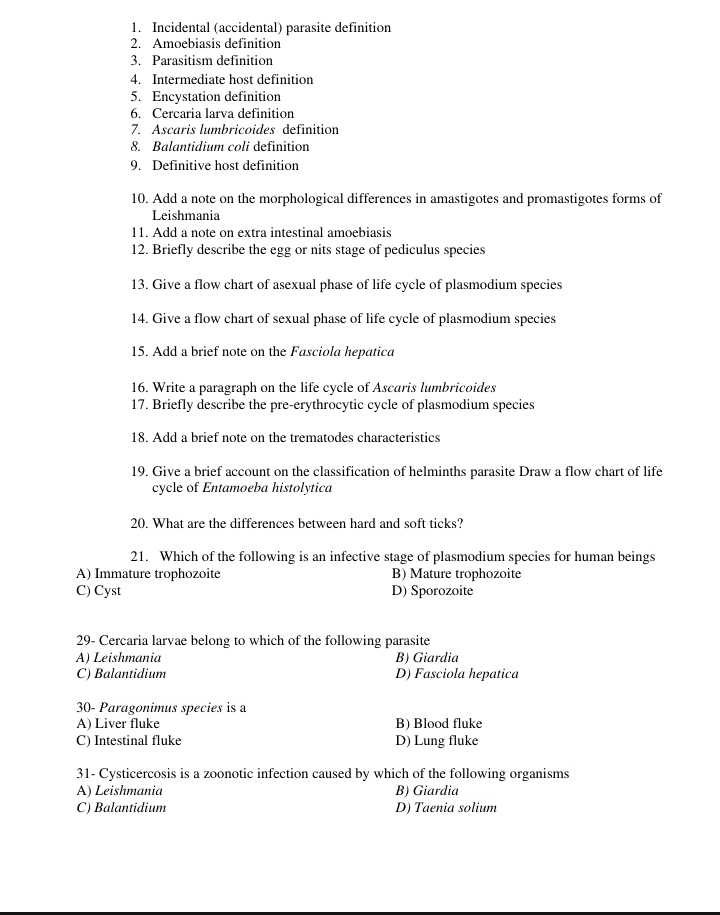1. Define incidental (accidental) parasite. 2. Define amoebiasis. 3. Define parasitism. 4. Define intermediate host. 5. Define encystation. 6. Define cercaria larva. 7. Define Asca... 1. Define incidental (accidental) parasite. 2. Define amoebiasis. 3. Define parasitism. 4. Define intermediate host. 5. Define encystation. 6. Define cercaria larva. 7. Define Ascaris lumbricoides. 8. Define Balantidium coli. 9. Define definitive host. 10. Add a note on the morphological differences in amastigotes and promastigotes forms of Leishmania. 11. Add a note on extra intestinal amoebiasis. 12. Briefly describe the egg or nits stage of pediculus species. 13. Give a flow chart of asexual phase of life cycle of plasmodium species. 14. Give a flow chart of sexual phase of life cycle of plasmodium species. 15. Add a brief note on the Fasciola hepatica. 16. Write a paragraph on the life cycle of Ascaris lumbricoides. 17. Briefly describe the pre-erythrocytic cycle of plasmodium species. 18. Add a brief note on the characteristics of trematodes. 19. Give a brief account on the classification of helminths parasite. Draw a flow chart of the life cycle of Entamoeba histolytica. 20. What are the differences between hard and soft ticks? 21. Which of the following is an infective stage of plasmodium species for human beings: A) Immature trophozoite B) Mature trophozoite C) Cyst D) Sporozoite? 29. Cercaria larvae belong to which of the following parasites: A) Leishmania B) Giardia C) Balantidium D) Fasciola hepatica? 30. Paragonimus species is: A) Liver fluke B) Blood fluke C) Intestinal fluke D) Lung fluke? 31. Cysticercosis is a zoonotic infection caused by which of the following organisms: A) Leishmania B) Giardia C) Balantidium D) Taenia solium?

Understand the Problem
The question is asking for definitions and explanations related to parasitology, including life cycles of various parasites, characteristics, and classifications. It encompasses various topics in the field of biology, specifically focusing on parasitic relationships and diseases.
Answer
21. Sporozoite, 29. Fasciola hepatica, 30. Lung fluke, 31. Taenia solium
The final answer is: 21. Sporozoite, 29. Fasciola hepatica, 30. Lung fluke, 31. Taenia solium
Answer for screen readers
The final answer is: 21. Sporozoite, 29. Fasciola hepatica, 30. Lung fluke, 31. Taenia solium
More Information
Sporozoites are the infective stage of Plasmodium transmitted to humans by mosquito bites. Cercaria larvae are stages in the life cycle of Fasciola hepatica. Paragonimus is a lung fluke. Cysticercosis is caused by Taenia solium.
Tips
Common mistakes include confusing parasite stages and mixing up the definitions of parasite-related terminology.
Sources
- Parasitology | The Carter Center - cartercenter.org
- Parasitology Glossary - USF Health - health.usf.edu
AI-generated content may contain errors. Please verify critical information